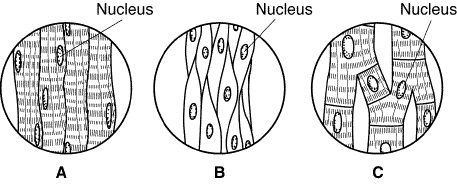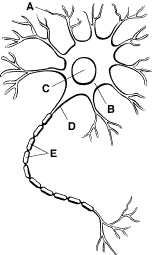Multiple Choice
Identify the
choice that best completes the statement or answers the question.
|
|
|
1
|
The three types of muscle tissues are
a) | skeletal, voluntary, and cardiac. | c) | skeletal, smooth, and
cardiac. | b) | smooth, cardiac, and involuntary. | d) | skeletal, cardiac, and
ridged. |
|
|
|
2
|
What is the smallest structural and functional unit of the nervous
system?
a) | organ | b) | tissue | c) | nerve | d) | neuron |
|
|
|
|
|
|
3
|
Refer to the illustration above. If neurotransmitters could not be cleared out
of a synapse after transmitting a message,
a) | the presynaptic neuron could not pass on its impulse. | b) | a postsynaptic
neuron would continue to be stimulated for an indefinite period of time. | c) | the postsynaptic
neuron would not be stimulated. | d) | the presynaptic neuron would not be
stimulated. |
|
|
|
4
|
Refer to the illustration above. In the diagram, label B indicates a
a) | neurotransmitter molecule. | c) | drug molecule. | b) | receptor
protein. | d) | neuromodulator
molecule. |
|
|
|
5
|
Tendons connect
a) | cartilage to bone. | c) | muscle to bone. | b) | muscle to muscle. | d) | bone to bone. |
|
|
|
6
|
The function of the excretory system is to control homeostasis and
a) | break down nutrients. | b) | absorb nutrients. | c) | remove
wastes. | d) | prevent infection. |
|
|
|
7
|
Tissue that is specialized to cover the inner and outer surfaces of the internal
organs is called
a) | connective tissue. | c) | muscles tissue. | b) | epithelial tissue. | d) | nerve tissue. |
|
|
|

Figure
36-2
|
|
|
8
|
In Figure 36-2, diagram A is an example of
a) | heart muscle. | b) | cardiac muscle. | c) | skeletal
muscle. | d) | smooth muscle. |
|
|
|
9
|
Which diagram(s) in Figure 36-2 show(s) muscles that are striated?
|
|
|
10
|
Neurotransmitters are
a) | found only in neurons with myelin sheaths. | b) | electrical
impulses. | c) | released at synapses. | d) | produced by
muscles. |
|
|
|

Figure
35-1
|
|
|
11
|
Refer to Figure 35-1. The cell body of a neuron collects information from which
structure?
|
|
|
12
|
Which of the following blood cells contain hemoglobin?
a) | white blood cells | b) | red blood cells | c) | platelets | d) | thrombocytes |
|
|
|
13
|
Where is cardiac muscle tissue located in the body?
a) | skull | b) | heart | c) | ribs | d) | bones |
|
|
|
14
|
Which body system acts as a transportation system?
a) | respiratory | b) | circulatory | c) | nervous | d) | excretory |
|
|
|
15
|
Red blood cells
a) | combat bacterial infection. | c) | transport
cholesterol. | b) | transport respiratory gases. | d) | destroy
viruses. |
|
|
|
16
|
Organs that work together form
a) | tissue systems. | c) | connective tissues. | b) | organ systems. | d) | homeopathic
tissues. |
|
|
|
17
|
The heart and the blood vessels are separate organs that form the
a) | digestive system. | c) | skeletal system. | b) | reproductive system. | d) | circulatory
system. |
|
|
|
18
|
Ligaments connect
a) | muscle to muscle. | b) | bone to bone. | c) | cartilage to
bone. | d) | bone to muscle. |
|
|
|
19
|
Which type of tissue lines your internal organs?
a) | epithelial | b) | connective | c) | muscle | d) | nerve |
|
|
|
20
|
Blood, bone, and cartilage are examples of
a) | connective tissue. | b) | epithelial tissue. | c) | organs of the
body. | d) | three different tissue types found in the body. |
|
|
|
21
|
Defending the body against bacterial infection and invasion by foreign
substances is a function of
a) | red blood cells. | c) | plasma. | b) | platelets. | d) | white blood
cells. |
|
|
|
22
|
Which system regulates and controls the body’s functions?
a) | integumentary system | b) | lymphatic system | c) | endocrine
system | d) | skeletal system |
|
|
|
23
|
From the smallest functional units to the largest, the body is organized as
follows:
a) | organ, cell, tissue, system, body. | c) | cell, tissue, organ, system,
body. | b) | cell, system, organ, tissue, body. | d) | system, organ, tissue, cell,
body. |
|
|
|
24
|
The four basic types of tissue in the human body are
a) | sight, smell, and hearing. | b) | thyroid, trachea, adenoid, and
bronchus. | c) | cell, organ, and organ system. | d) | muscle, nervous, connective, and
epithelial. |
|
|
|
25
|
Hormones are essential to maintaining homeostasis mainly because
a) | they act faster than nerve impulses. | b) | the body requires them for digesting
food. | c) | they catalyze specific chemical reactions in brain cells. | d) | they cause specific
responses in specific cells. |
|
|
|
26
|
A group of similar cells that perform a single function is called a(an)
a) | organ system. | b) | organ. | c) | tissue. | d) | nerve. |
|
|
|
|
|
|
27
|
Refer to the illustration above. The cells shown in the diagram are
a) | white blood cells. | c) | platelets. | b) | red blood cells. | d) | filled with
plasma. |
|
|
|
28
|
The endocrine system
a) | affects only the reproductive system. | b) | competes with the nervous
system. | c) | is made up primarily of glands with ducts. | d) | releases hormones
into the bloodstream. |
|
|
|
29
|
Smooth muscles can be found
a) | at the knee joint. | c) | attached to the skeleton. | b) | in internal
organs. | d) | in the wrist
bones. |
|
|
|
30
|
The process by which organ systems maintain a controlled, stable, internal
environment is called
a) | homeostasis. | b) | teamwork. | c) | circulation. | d) | organization. |
|